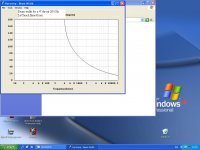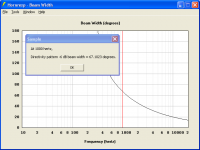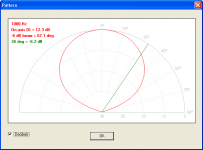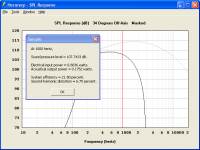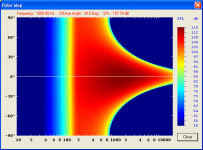You should check with your lokal ISP. The problem seems to persist on your side - serverside the infrastrukture changed many times so drastically, even the storage location (it was australia, then US, now Europe) that the "error" can only be on the "receiver side".I am still unable to download Hornresp from home due to my dial up connection. You may remember we discussed this before and there was never a resolution. I tried again just now to be sure, it downloaded 295K, said it was done, and when I try to install it gives error message "Zip file is damaged, truncated or has been changed since it was created. If you downloaded this file try downloading again." I'll download 28.30 as soon as I get to a high speed connection and comment on that version.
Try installing a download manager for these kinds of things. This way, if a download breaks up, it will be picked up automaitcally again where it last stopped and will be finished. Getright for example will do a good job, ... there are so many out there....
I use to have this problem a lot with zip files from certain sites, so sent you a PM with it attached to your hotmail account to see if that might be the problem.
GM
Thanks again for the effort but Hotmail must really hate Hornresp...
When I opened your email I got the message "Windows Live Hotmail has blocked some attachments in this message because they appear to be unsafe."
Hotmail thinks things are unsafe all the time but usually gives the option to download anyway. Not in this case, it's unblockable. I tried to forward the email to my gmail account but Hotmail says "Warning Files Setup1.exe are blocked from forwarding."
I've never had this issue before. Anyway, more info in my next post...
You should check with your lokal ISP. The problem seems to persist on your side - serverside the infrastrukture changed many times so drastically, even the storage location (it was australia, then US, now Europe) that the "error" can only be on the "receiver side".
Try installing a download manager for these kinds of things. This way, if a download breaks up, it will be picked up automaitcally again where it last stopped and will be finished. Getright for example will do a good job, ... there are so many out there....
First, some brief notes on the issue.
1. I never had a problem with downloading Hornresp until David McBean notified us that dial up users might have problems. At that point I did indeed start to have problems.
2. When Hornresp switched hosting services I tried again but the problem persisted, exactly the same as it had been, in exactly the same fashion.
3. At that point I assumed the problem had to be on my end so I tried downloading Hornresp with at least 3 different computers that I use regularly, with several different browsers. The problem persisted on all computers, exactly the same. None of them were able to download Hornresp with a dial up connection but they all work with high speed.
4. I've never had any problems downloading anything before, even files as large as 40 mb on dial up. Only Hornresp refuses to download.
5. Firefox is one of the browsers that I use, and it has a weird kind of a download manager built in. It doesn't matter when downloading Hornresp, I get a message that says the download is complete even though it isn't, so there's nothing to try to resume. The only option is try to redownload, but it does the same thing every time.
6. I had no problem whatsoever downloading the Hornresp setup files that soho54 posted here for me a couple of days ago.
7. About an hour ago, after Hotmail refused to allow me access to GM's attachment I got frustrated and dragged my "just in case everything else fails" computer out of the back of the closet, a very old Pentium 1 with Internet Explorer 6 that I haven't even looked at in several years. With that computer I was able to download Hornresp from David McBean's host with no problem.
So the problem is definitely on my end, although I have no idea what it might be. My computers are all healthy, I format and reinstall Windows regularly to keep everything smooth. I might try to figure out what the issue is at some point, but I have a working solution atm so I'm not too worried about it.
I'll play with v28.30 tonight and comment on the sliders later on.
Thanks for all the responses.
Last edited:
is this working for you?
Version 28.30 - Product Number 2830-110101
It´s the setup files compresse with 7zip, stored in a zip file
Yup, it downloads in full with no problem at all. (I didn't try to open it yet, but opening it isn't the issue.) It seems I can download Hornresp from anywhere except David McBean's host or Hotmail.
Interesting, the zip file I DLed and forwarded to tony is 1095 KB.
GM
The difference is probably due to how he zipped it.
I finally got a couple of minutes to test drive v28.30, not as much as I'd like but I was pretty busy this evening and I wanted to report back today.
At first glance I like the sliders in 28.30 much better than 28.20. The old slider behavior was fine, the current version is fine, I just didn't like 28.20 at all.
Thanks.
At first glance I like the sliders in 28.30 much better than 28.20. The old slider behavior was fine, the current version is fine, I just didn't like 28.20 at all.
Thanks.
At first glance I like the sliders in 28.30 much better than 28.20.
Hi just a guy,
Thanks for the update. Glad to hear that the Hornresp Loudspeaker Wizard area slider operation is now more acceptable to you. Realising that Version 28.20 had significant shortcomings I tried to integrate the best features from all the previous releases into Version 28.30.
Once you become more familiar with it, hopefully you will like the latest release best of all
Kind regards,
David
Last edited:
How do I use HornResp to match dispersion at crossover point?
Hello David McBean and all others,
First of all: Thanks for a truly great piece of software!
Now to my question: I would like to know how to use HornResp to match the dispersion at the crossover point (e.g. 1300 Hz) between, say, a non CD mid horn and a non CD tweeter horn. For instanse, if I have a LeCleach flared or tractrix flared mid circular horn with a Fc=200 Hz, then how do I "see" the dispersion at different frequencies?
I the “Help” section I can see that this should be possible using [Tools] – [Directivity Response], but unfortunately the features provided does make much sense to me (which I am sure has more to do with my understanding of the issue, than limitations of the software).
Thanks a lot!
Best regards
Peter
Hello David McBean and all others,
First of all: Thanks for a truly great piece of software!
Now to my question: I would like to know how to use HornResp to match the dispersion at the crossover point (e.g. 1300 Hz) between, say, a non CD mid horn and a non CD tweeter horn. For instanse, if I have a LeCleach flared or tractrix flared mid circular horn with a Fc=200 Hz, then how do I "see" the dispersion at different frequencies?
I the “Help” section I can see that this should be possible using [Tools] – [Directivity Response], but unfortunately the features provided does make much sense to me (which I am sure has more to do with my understanding of the issue, than limitations of the software).
Thanks a lot!
Best regards
Peter
Hey while I' thinking about it I have something to ask about.
What is the difficulty in making an area where we could do horns with multiple taps alla unity type horns. I have been working on a few.
And I'm just a little bit tired of that byzantine nightmare called AKaBak. I have hardly any hair left to pull out!
If I don't ask I don't get.
I probably won't get but you know...
Even the hardest rocks get warn away by soft water...
What is the difficulty in making an area where we could do horns with multiple taps alla unity type horns. I have been working on a few.
And I'm just a little bit tired of that byzantine nightmare called AKaBak. I have hardly any hair left to pull out!
If I don't ask I don't get.
I probably won't get but you know...
Even the hardest rocks get warn away by soft water...
I would like to know how to use HornResp to match the dispersion at the crossover point (e.g. 1300 Hz) between, say, a non CD mid horn and a non CD tweeter horn. For instanse, if I have a LeCleach flared or tractrix flared mid circular horn with a Fc=200 Hz, then how do I "see" the dispersion at different frequencies?
Hi Peter,
If you are referring to acoustic dispersion in the strictest sense, then I don't think that Hornresp can help you much. If however you simply want to check the directivity characteristics of a particular speaker over a given frequency range, then Tools > Directivity > Beam Width and Tools > Directivity > Polar Map would be good places to start (bearing in mind that the Hornresp directivity models are indicative only).
Kind regards,
David
What is the difficulty in making an area where we could do horns with multiple taps alla unity type horns.
Hi Mark,
This feature has been requested before by others, and unfortunately the answer has to remain the same. The Hornresp user input interface would require significant modification and many coding changes to accommodate the additional functionality. I am not in a position to do this.
Sorry, but AkAbak is your only option
Kind regards,
David
Hi David,
Thanks a lot for your reply! I will try what you suggest and then eventually get back
Best regards
Peter
Thanks a lot for your reply! I will try what you suggest and then eventually get back
Best regards
Peter
Hi Peter,
If you are referring to acoustic dispersion in the strictest sense, then I don't think that Hornresp can help you much. If however you simply want to check the directivity characteristics of a particular speaker over a given frequency range, then Tools > Directivity > Beam Width and Tools > Directivity > Polar Map would be good places to start (bearing in mind that the Hornresp directivity models are indicative only).
Kind regards,
David
Directivity - sanity check
Hi David,
I used HornResp to simulate the beamwidth of a 200 Hz LeCleach flared horn (see attachment). One question in order to check whether I understand this right:
Let's say I wanted to build a conical tweeter horn to match the 200 Hz LeCleach horn at 1500 Hz (crossover point), then - if I understand the simulation correct - I should build a conical horn with 60 degrees dispersion for the tweeter.
Or alternatively, if I wanted to build a conical tweeter horn to match the dispersion of the 200 Hz LeCleach mid horn at 900 Hz (crossover point), then the dispersion of the conical horn should have 80 degree dispersion.
Am I correct?
Thanks a lot!
Best regards
Peter
Hi David,
I used HornResp to simulate the beamwidth of a 200 Hz LeCleach flared horn (see attachment). One question in order to check whether I understand this right:
Let's say I wanted to build a conical tweeter horn to match the 200 Hz LeCleach horn at 1500 Hz (crossover point), then - if I understand the simulation correct - I should build a conical horn with 60 degrees dispersion for the tweeter.
Or alternatively, if I wanted to build a conical tweeter horn to match the dispersion of the 200 Hz LeCleach mid horn at 900 Hz (crossover point), then the dispersion of the conical horn should have 80 degree dispersion.
Am I correct?
Thanks a lot!
Best regards
Peter
Hi Peter,
If you are referring to acoustic dispersion in the strictest sense, then I don't think that Hornresp can help you much. If however you simply want to check the directivity characteristics of a particular speaker over a given frequency range, then Tools > Directivity > Beam Width and Tools > Directivity > Polar Map would be good places to start (bearing in mind that the Hornresp directivity models are indicative only).
Kind regards,
David
Attachments
Am I correct?
Hi Peter,
You are interpreting the Hornresp Beam Width chart correctly. For the example you have given, at 1500 Hz and 30 degrees off-axis (60 degrees beam width), the SPL is down 6 dB from its value on axis. Similarly, at 900 Hz the SPL is down 6 dB from its on-axis value at an angle 40 degrees off-axis (80 degrees beam width).
Note that all four Hornresp directivity charts are inter-related. To illustrate, I have attached the results for a 160Hz Le Cléac'h horn with T = 0.80.
1. From the Beam Width chart you can see that the -6 dB beam width at 1000 Hz is 67.1023 degrees. For the purpose of the exercise we will assume that the beam width is actually 68 degrees, equivalent to an off-axis angle of 34 degrees.
2. Now look at the 1000 Hz directivity pattern. The "-6 dB beam" is given as 67.1 degrees, which is consistent with the value obtained in 1 above. 34 degrees off-axis the SPL is down 6.2 dB from the on-axis value. This is also consistent with the earlier result - the value would be exactly -6 dB if we could sample at precisely the half-beamwidth angle, rather than at the 34 degree approximation.
3. The attached SPL response chart compares the response 34 degrees off-axis (black trace) to the on-axis response (gray trace). At 1000 Hz the off-axis response is 6.2 dB down, consistent with the value obtained in 2 above. At 1000 Hz and 34 degrees off-axis the SPL is 107.7433 dB.
4. If you now check the polar map, you will see that at 1000 Hz and an off-axis angle of 34 degrees, the SPL is 107.74 dB, the same value (rounded to two decimal places) as given in 3 above.
Hope this helps to clarify the Hornresp directivity results.
Kind regards,
David
Attachments
Last edited:
Hi David,
Thanks a lot for your thorough and clear reply!
Best regards
Peter
Thanks a lot for your thorough and clear reply!
Best regards
Peter
Hi Peter,
You are interpreting the Hornresp Beam Width chart correctly. For the example you have given, at 1500 Hz and 30 degrees off-axis (60 degrees beam width), the SPL is down 6 dB from its value on axis. Similarly, at 900 Hz the SPL is down 6 dB from its on-axis value at an angle 40 degrees off-axis (80 degrees beam width).
Note that all four Hornresp directivity charts are inter-related. To illustrate, I have attached the results for a 160Hz Le Cléac'h horn with T = 0.80.
1. From the Beam Width chart you can see that the -6 dB beam width at 1000 Hz is 67.1023 degrees. For the purpose of the exercise we will assume that the beam width is actually 68 degrees, equivalent to an off-axis angle of 34 degrees.
2. Now look at the 1000 Hz directivity pattern. The "-6 dB beam" is given as 67.1 degrees, which is consistent with the value obtained in 1 above. 34 degrees off-axis the SPL is down 6.2 dB from the on-axis value. This is also consistent with the earlier result - the value would be exactly -6 dB if we could sample at precisely the half-beamwidth angle, rather than at the 34 degree approximation.
3. The attached SPL response chart compares the response 34 degrees off-axis (black trace) to the on-axis response (gray trace). At 1000 Hz the off-axis response is 6.2 dB down, consistent with the value obtained in 2 above. At 1000 Hz and 34 degrees off-axis the SPL is 107.7433 dB.
4. If you now check the polar map, you will see that at 1000 Hz and an off-axis angle of 34 degrees, the SPL is 107.74 dB, the same value (rounded to two decimal places) as given in 3 above.
Hope this helps to clarify the Hornresp directivity results.
Kind regards,
David
Hi, can I use Hornresp to calculate the SPL response of a driver without a baffle?
Hi vadi,
Yes you can, by setting Ang = 4.0 x Pi, S1 = Sd, S2 = Sd and L12 (Con) = 0.01. Note that the 'combined response' SPL will be very low because the signals from the front and rear sides of the diaphragm are almost 180 degrees out of phase, resulting in nearly perfect cancellation.
Kind regards,
David
Last edited:
- Home
- Loudspeakers
- Subwoofers
- Hornresp
